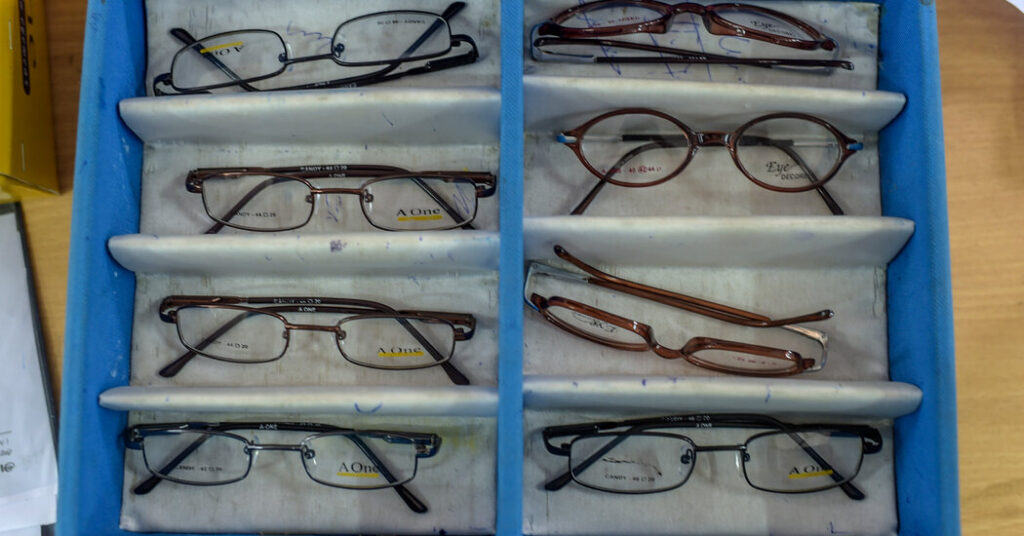If you’re 50 or older and studying this text, likelihood is you’re sporting a pair of cheap studying glasses to appropriate your presbyopia, or farsightedness, the age-related decline in imaginative and prescient that makes it progressively harder to see superb print and tiny objects.
Eventually, everybody will get the situation.
But for practically a billion folks within the creating world, studying glasses are a luxurious that many can’t afford. According to the World Health Organization, the dearth of entry to corrective eyewear inhibits studying amongst younger college students, will increase the probability of visitors accidents and forces thousands and thousands of middle-age manufacturing facility employees and farmers to depart the work power too early.
Uncorrected presbyopia, not surprisingly, makes it tougher for breadwinners to help their households. That’s the conclusion of a brand new examine which discovered that garment employees, artisans and tailors in Bangladesh who have been supplied with free studying glasses skilled a 33 % enhance in revenue in comparison with those that weren’t given glasses.
The examine, printed on Wednesday within the journal PLOS One, included greater than 800 adults in rural Bangladesh, a lot of whom work in jobs that require intense consideration to element. Half of the members — a mixture of tea pickers, weavers and seamstresses between 35 and 65 — have been randomly chosen to obtain a free pair of studying glasses. The others weren’t given glasses.
Researchers adopted up eight months later and located that the group with glasses had skilled a big bump in revenue, receiving a median month-to-month revenue of $47.10, in comparison with $35.30 for the members who didn’t have glasses.
The examine topics have been evenly divided between female and male, and barely greater than a 3rd have been literate.
Dr. Nathan Congdon, the examine’s lead writer and an ophthalmologist at Queen’s University Belfast in Northern Ireland, mentioned the outcomes added to a mounting physique of proof that quantifies the financial impression of uncorrected imaginative and prescient in components of the world the place the roughly $1.50 it prices to purchase a pair of so-called readers is out of attain for a lot of.
“All of us would be happy with a 33 percent jump in income,” mentioned Dr. Congdon, who makes a speciality of low-cost fashions of eye care supply. “But what makes the results especially exciting is the potential to convince governments that vision care interventions are as inexpensive, cost effective and life-changing as anything else that we can offer in health care.”
Dr. David S. Friedman, a professor of ophthalmology at Harvard Medical School who was not concerned with the examine, mentioned he was struck by the outcomes and hoped future research would affirm the findings. “These economic impacts are large, real and could have a substantial impact on people’s lives,” he mentioned.
Eye care has lengthy been the uncared for stepchild of public well being within the creating world; infectious illnesses like tuberculosis, malaria and AIDS have a tendency to attract extra sturdy authorities and philanthropic help. But imaginative and prescient impairment is a severe world difficulty, with a projected price of greater than $400 billion in misplaced productiveness, in response to the W.H.O.
Experts say spending on eye care can have a substantial impression on communities, each when it comes to elevated financial output and improved high quality of life. Compared to different, extra intractable well being issues, addressing presbyopia is pretty cheap. Glasses can usually be produced for lower than $2 a pair, and fittings are often carried out by group employees who may be skilled in only a day.
Misha Mahjabeen, the Bangladesh nation director for VisionSpring, a nonprofit group that participated within the examine, mentioned an absence of sources was only one obstacle to the elevated distribution of studying glasses. In many Bangladeshi villages, she mentioned, group employees should cope with the social stigma related to sporting glasses, particularly for girls.
Overall, the well being wants of girls in Bangladesh take a again seat to these of males. “In our male-dominated society, when the man has a problem, it requires immediate attention, but women, they can wait,” she mentioned.
But the consequences of declining imaginative and prescient may be particularly pronounced for girls, who are sometimes answerable for incomes further revenue for his or her households along with the kid care and family chores, Ms. Mahjabeen mentioned. “When it takes longer to sew and clean, or you can’t pick out all the stones from the rice, in some households it results in domestic violence,” she mentioned.
VisionSpring distributes greater than two million pairs of glasses a 12 months all through South Asia and Africa, up from 300,000 in 2018.
The examine in PLOS One builds on earlier analysis involving tea pickers in India that discovered a big leap in productiveness amongst examine members given studying glasses. The paper, a randomized examine printed in The Lancet Global Health in 2018, documented a 22-percent enhance in productiveness amongst employees who had been given glasses. For these over 50, productiveness elevated by practically 32 %.
Agad Ali, 57, a Bangladeshi tailor within the city of Manikganj, was amongst those that acquired a pair of glasses as a part of the examine that was printed this week. In an interview performed by a group well being employee and despatched through e mail, he described how worsening presbyopia had made it more and more laborious to string needles and sew clothes, including to the time required to complete every tailoring job. Over time, he mentioned, some prospects went elsewhere, and his revenue started to say no. “It made me feel very helpless,” he mentioned.
Since receiving the glasses, he mentioned, his revenue had doubled. “These glasses are like my lifeline,” he instructed the group well being employee. “I could not do my job without them.”


